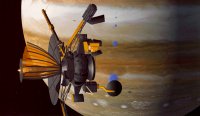|
The
Galileo Spacecraft
The
@stro object for the week of 02/21/2000

image
courtesy of JPL
The Galileo
Spacecraft. On
October 18, 1989 the Galileo spacecraft, named for the famous Jovian
observer Galileo Galilei (1564-1642), began its journey to Jupiter
and its moon system after being launched from the Space Shuttle
Atlantis. It arrived at Jupiter and entered orbit on December 7,
1995. The spacecraft was made up of the Galileo Orbiter and Galileo
Probe. The Probe was dropped from the Orbiter on December 7, 1995
and made a slow decent through Jupiter's highly turbulent upper
atmosphere returning scientific data including information on Jupiter's
pressure, temperature, density, lightening, wind speed and other
readings before its signal was lost.
The Galileo
Orbiter has completed several orbits around Jupiter and continues
to operate well beyond its expected capacity. In fact, the Orbiter
has received more than twice the radiation than it was built to
survive. It has investigated many of Jupiter's moons, the ring system,
radiation belts and thousands of images have been returned to scientists
on Earth. It has provided more evidence for remarkable theories,
such as the theory that Europa contains liquid water beneath its
icy surface. The original mission for the Orbiter was due to last
two years and ended in December, 1997. However, the Orbiter entered
an extended mission that it is currently operating in. The extended
mission was supposed to end in January, 2000 but was extended again.
On February
22, 2000 Galileo will make its third pass by Io and execute its
lowest flyby of that active moon, flying only 200 kilometers (124
miles) from its volcanic surface. During a low flyby in October
1999, the Orbiter went into safe mode due to extreme radiation from
Jupiter. It is expected that a similar problem may occur this time
around as well. Among other goals of this flyby is the chance to
view the results of eruptions viewed during the previous Io encounters.
| Current
information for the Galileo Spacecraft: |
| Mission:
Exploration of the Jupiter system |
| Launch
Date: Oct. 18, 1989 |
| Arrival
at Jupiter: Dec. 7, 1995 |
| Probe
dropped into Jupiter's Atmosphere: Dec. 7, 1995 |
| Expected
completion date of mission: Jan 2000, but was extended |
more
info on the Galileo Mission
more
info on the Galileo Probe
|